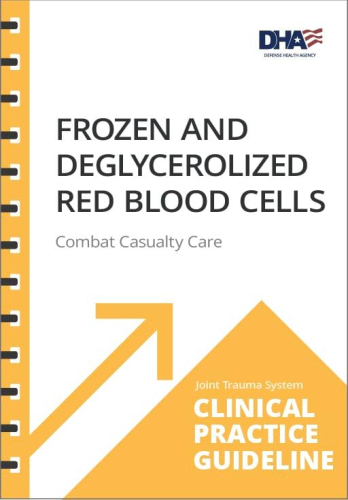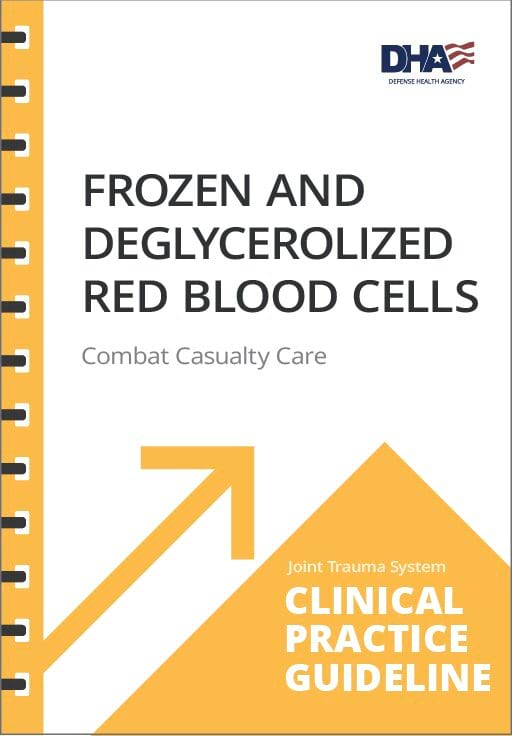Background
Deglycerolized Red Blood Cells (DRBCs) are derived from 450-500 ml of whole blood collected in Citrate/Phosphate/Dextrose (CPD) or Citrate/Phosphate/Dextrose/Adenine (CPDA-1) collection bags. DRBCs can also be made from additive solution Red Blood Cell (RBC) units such as CPD/AS-1, CPD/AS-5 or CP2D/AS-3 if these are first centrifuged to concentrate the RBCs to hematocrit of about 75%. The RBCs are stored for up to 6 days at 1 – 6 °C before being frozen in a cryoprotectant (40% w/v glycerol), and stored in the frozen state at minus 65 °C or colder for up to 10 years. Once it is determined that they will be needed for transfusion, the frozen RBCs are thawed. They are then deglycerolized by sequential washing with hypertonic (12%) saline followed by normal (0.9%) saline mixed with 0.2% glucose. Following deglycerolization, they are re-suspended in AS-3 additive solution and stored at 1 – 6 °C, until ready for transfusion. DRBCs suspended in AS-3 are Food and Drug Administration (FDA)-approved for transfusion for up to 14 days when processed on the Haemonetics Automated Cell Processor ACP215, an FDA 510(k)-cleared, closed processing system device. DRBCs are licensed under the respective Service Blood Program licenses.
The first operational frozen blood bank was established in 1956 at Chelsea Naval Hospital (Boston), in part to determine the practicality of frozen blood usage aboard Navy ships. In 1966, under Department of Defense (DoD) direction, the Navy Bureau of Medicine and Surgery established the first frozen blood bank in a combat zone at Navy Station Hospital, DaNang, Republic of South Vietnam. Over a seven-month period, 465 DRBC units were transfused to severely injured casualties. In the 1980s, the DoD froze 68,000 RBC units. Those units were pre-positioned throughout several geographic Combatant Commands (COCOMs) in direct support of current and future military medical contingency operations.
FDA-approved DRBCs are typically used at Role 2 and higher Medical Treatment Facilities (MTFs), but could be used in the pre-hospital setting after thawing and deglycerolization if appropriately transported. DRBC storage and processing are organic to certain naval vessels and Service depots in the Pacific Command (PACOM) Area of Responsibility. Army MTFs and Medical Detachment Blood Support units do not have the organic mission or capability to process and store frozen units of blood. Use of this capability is based on operational necessity outside of PACOM.
Clinical Indications for Use
Each unit of DRBCs:
- Should be considered equivalent to a fresh unit of RBCs since they are frozen within 6 days of collection and have a 14-day shelf-life upon deglycerolization.
- Contains more than 80% of the RBCs present in the original unit of blood.
- Provides the same physiologic benefits as liquid RBCs.
- Carries the same expectation for post-transfusion survival as liquid-stored RBCs.
- Contains significantly lower concentrations of proteins associated with non-hemolytic transfusion reactions.
- The primary indication for use of frozen and deglycerolized RBCs is as a supplement to liquid RBCs during surge periods of increased transfusion requirements in order to decrease casualty hemorrhagic morbidity and mortality.
DRBCs may be used in lieu of liquid-stored RBCs for all RBC transfusion requirements including massive transfusions. The Joint Trauma System (JTS) Performance Improvement Branch analyzed data from the DoD Trauma Registry (DoDTR) and Massive Transfusion database and found no statistically significant difference in outcomes or transfusion-related complications between patients who received at least 1 unit of DRBCs as part of their massive transfusion and those who received none (See Appendix A). A single center prospective randomized trial comparing DRBCs to liquid-stored RBCs in stable trauma patient’s revealed decreased inflammatory marker and D-dimer levels and increased tissue oxygenation measured by near infrared spectroscopy in patients transfused DRBCs. There were no differences in clinical outcomes. - Transfusion monitoring:
- Clinical: Treat as a routine liquid-stored RBC transfusion before, during, and after transfusion, and for a suspected or actual adverse event.
- Laboratory: Consider obtaining pre- and post-transfusion Hgb/Hct and Base Excess/Deficit or lactate levels.
Documentation
Clinical documentation for a frozen and deglycerolized transfusion is the same as for a liquid transfusion. In addition:
- The physician may order use of DRBCs (for example, when washed RBCs would be preferred to reduce risk of transfusion reaction to plasma proteins in some patients), but in practice, the MTF will use DRBCs and liquid-stored RBCs interchangeably based on inventories and logistical considerations.
- The laboratory will establish and maintain a process to document DRBC transfusions in a manner that will facilitate future evaluation of recipients, including but not limited to:
- Blood component identifiers.
- Date of blood component receipt in frozen state.
- Date of thaw/deglycerolization/additive process and resulting expiration date.
- Casualty identifiers (including nationality and ABO/Rh categorization).
- Date of transfusion.
- Transfusion indication.
- Transfusion reaction, nature and outcome.
Operational Considerations
Thawing and deglycerolization are time-consuming processes. Thawing a frozen RBC unit takes about 35 minutes in a plasma thawer and about 45 minutes in a 42°C water bath. Deglycerolization of one unit in the ACP215 takes about one hour. Real world use of this technology suggests that a single technician operating three ACP215’s can prepare three units of DRBCs every three hours. In periods of predictable operational requirements, it may be advisable to pre-thaw and deglycerolize several units so as not to incur the delay of preparation at the time they are needed.
Performance Improvement (PI) Monitoring
Intent (Expected Outcomes)
All patients who receive DRBC transfusions have accurate documentation in the medical record of the quantity of transfused blood and any transfusion-related adverse events.
Performance/Adherence Measures
In patients who were transfused DRBCs, there was accurate documentation in the medical record as to the quantity of blood transfused and any transfusion-related adverse events.
Data Source
- Patient Record
- DoDTR
- CENTCOM blood bank logs
- Theater Medical Data Store
System Reporting & Frequency
The above constitutes the minimum criteria for PI monitoring of this CPG. System reporting will be performed biannually; additional PI monitoring and system reporting may be performed as needed.
The system review and data analysis will be performed by the JTS Director and the JTS Performance Improvement Branch.
Responsibilities
It is the combined responsibility of the trauma team leader and blood bank officer to ensure familiarity, appropriate compliance and PI monitoring at the local level with this CPG.
-
- Emergency War Surgery Handbook, Fourth United States Revision, 2013, Borden Institute, US Army Medical Department and School, Ft. Sam Houston, Texas.
- Glycerolization and deglycerolization of red blood cells in a closed system using the Haemonetics ACP215, Naval Blood Research Laboratory, C. Robert Valeri, http://www.nbrl.org/SOP/ACP215/ACP215All.html
- Hampton DA, Wiles C, Fabricant LJ, Kiraly L, Differding J, Underwood S, Le D, Watters J, Schreiber MA. Cryopreserved red blood cells are superior to standard liquid red blood cells. J Trauma Acute Care Surg. 2014 Jul;77(1):20-7; discussion 26-7. PMID:24977750
- Fabricant L, Kiraly L, Wiles C, Differding J, Underwood S, Deloughery T, Schreiber M. Cryopreserved deglycerolized blood is safe and achieves superior tissue oxygenation compared with refrigerated red blood cells: a prospective randomized pilot study. J Trauma Acute Care Surg. 2013 Feb;74(2):371-6; discussion 376- 7. PMID:23354227
Appendix A: Massive Transfusion with DRBC Compared to Standard Massive Transfusion
| | p value | |
| Overall Mortality | 0,241 | 63 cases/63 controls matched for age, ISS, total RBC within 24 hours, patient category, gender |
| Complications | p value | |
| Transfusion Reaction | N/A | No cases in sample |
| Coagulopathy | 0,271 | 63 cases/63 controls matched for age, ISS, total RBC within 24 hours, patient category, gender, initial Base deficit, initial temperature, initial INR |
| Renal Failure | 0,57 | 60 cases/60 controls matched for age, ISS, total RBC within 24 hours, patient category, gender, extremity injury |
| DVT | 0,753 | 23 cases/23 controls matched for age, ISS, total RBC within 24 hours, patient category, gender, extremity injury |
| Respiratory Failure | N/A | No cases in sample |
| Sixty three patients in Afghanistan were identified between Jan 10 - Sep 11 as having a massive transfusion which included deglycerolized blood (DRBC). A control population of 525 patients with non-DRBC massive transfusion from the same time period and theater was found in the JTTR to provide comparison of overall mortality. |
| CONCLUSION: With the data available, there appears to be no statistical difference in mortality outcome in theater for patients receiving deglycerolized blood (DRBC) as part of a massive transfusion when compared to patients receiving no DRBC as part of a massive transfusion. Additionally, there seems to be no significant difference between massive transfusions with DRBC and without DRBC in the development of complications for transfusion reaction, coagulopathy, renal failure, deep vein thrombosis (DVT), or respiratory failure. |
| Completed 23 March 2012 |
Appendix B: Additional Information Regarding Off-Label Uses In CPGs
Purpose
The purpose of this Appendix is to ensure an understanding of DoD policy and practice regarding inclusion in CPGs of “off-label” uses of U.S. Food and Drug Administration (FDA)–approved products. This applies to off-label uses with patients who are armed forces members.
Background
Unapproved (i.e. “off-label”) uses of FDA-approved products are extremely common in American medicine and are usually not subject to any special regulations. However, under Federal law, in some circumstances, unapproved uses of approved drugs are subject to FDA regulations governing “investigational new drugs.” These circumstances include such uses as part of clinical trials, and in the military context, command required, unapproved uses. Some command requested unapproved uses may also be subject to special regulations.
Additional Information Regarding Off-Label Uses in CPGs
The inclusion in CPGs of off-label uses is not a clinical trial, nor is it a command request or requirement. Further, it does not imply that the Military Health System requires that use by DoD health care practitioners or considers it to be the “standard of care.” Rather, the inclusion in CPGs of off-label uses is to inform the clinical judgment of the responsible health care practitioner by providing information regarding potential risks and benefits of treatment alternatives. The decision is for the clinical judgment of the responsible health care practitioner within the practitioner-patient relationship.
Additional Procedures
Balanced Discussion
Consistent with this purpose, CPG discussions of off-label uses specifically state that they are uses not approved by the FDA. Further, such discussions are balanced in the presentation of appropriate clinical study data, including any such data that suggest caution in the use of the product and specifically including any FDA-issued warnings.
Quality Assurance Monitoring
With respect to such off-label uses, DoD procedure is to maintain a regular system of quality assurance monitoring of outcomes and known potential adverse events. For this reason, the importance of accurate clinical records is underscored.
Information to Patients
Good clinical practice includes the provision of appropriate information to patients. Each CPG discussing an unusual off-label use will address the issue of information to patients. When practicable, consideration will be given to including in an appendix an appropriate information sheet for distribution to patients, whether before or after use of the product. Information to patients should address in plain language: a) that the use is not approved by the FDA; b) the reasons why a DoD health care practitioner would decide to use the product for this purpose; and c) the potential risks associated with such use.




















